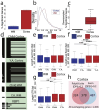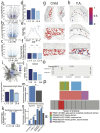This is a preprint.
A spatial long-read approach at near-single-cell resolution reveals developmental regulation of splicing and polyadenylation sites in distinct cortical layers and cell types
- PMID: 40661641
- PMCID: PMC12259066
- DOI: 10.1101/2025.06.10.658877
A spatial long-read approach at near-single-cell resolution reveals developmental regulation of splicing and polyadenylation sites in distinct cortical layers and cell types
Update in
-
A spatial long-read approach at near-single-cell resolution reveals developmental regulation of splicing and polyadenylation sites in distinct cortical layers and cell types.Nat Commun. 2025 Aug 29;16(1):8093. doi: 10.1038/s41467-025-63301-9. Nat Commun. 2025. PMID: 40883294 Free PMC article.
Abstract
Genome-wide single-cell and spatial long-read approaches have gained traction, but mostly lack single-cell resolution - and yield limited read lengths. Here, we introduce spatial ISOform sequencing (Spl-ISO-Seq), which reveals exons and polyadenylation sites from long reads with near-single-cell resolution. Spl-ISO-Seq selects long cDNAs and doubles to triples read lengths compared to standard preparations. Adding a highly specific software tool (Spl-ISOquant) and comparing human post-mortem pre-puberty samples of the visual cortex (8-11 years) to post-puberty samples (16-19 years), we find that cortical layers harbor stronger splicing and poly(A)-site regulation than the adjacent white matter, with enrichment of multiple protein-domain types. For oligodendrocytes however, developmental splicing changes are stronger in white matter. Among cortical layers, layer 4 has the most developmental changes in alternative-exon inclusion in excitatory neurons and in poly(A) sites. We also find many repeat elements, especially ERV1 long terminal repeats downstream of developmentally-regulated layer 4 exons. Overall, alternative splicing changes are linked to synapses - specifically at the post-synapse. Age-linked splicing changes in layers 1-3 and 4 are associated with autism spectrum disorder but not with schizophrenia, amyotrophic lateral sclerosis and Alzheimer's disease. These results root developmental splicing changes during puberty and the resulting protein changes in specific layers and cell types. More generally, our new technologies enable new observations for any complex tissue.
Conflict of interest statement
CONFLICTS OF INTEREST H.U.T. has presented at user meetings of 10x Genomics, Oxford Nanopore Technologies, and Pacific Biosciences, which in some cases included payment for travel and accommodations. The other authors declare no competing interests.
Figures






References
-
- Johnson J. M. et al. Genome-wide survey of human alternative pre-mRNA splicing with exon junction microarrays. Science 302, 2141–2144 (2003). - PubMed
-
- Pan Q., Shai O., Lee L. J., Frey B. J. & Blencowe B. J. Deep surveying of alternative splicing complexity in the human transcriptome by high-throughput sequencing. Nat Genet 40, 1413–1415 (2008). - PubMed
Publication types
Grants and funding
LinkOut - more resources
Full Text Sources
